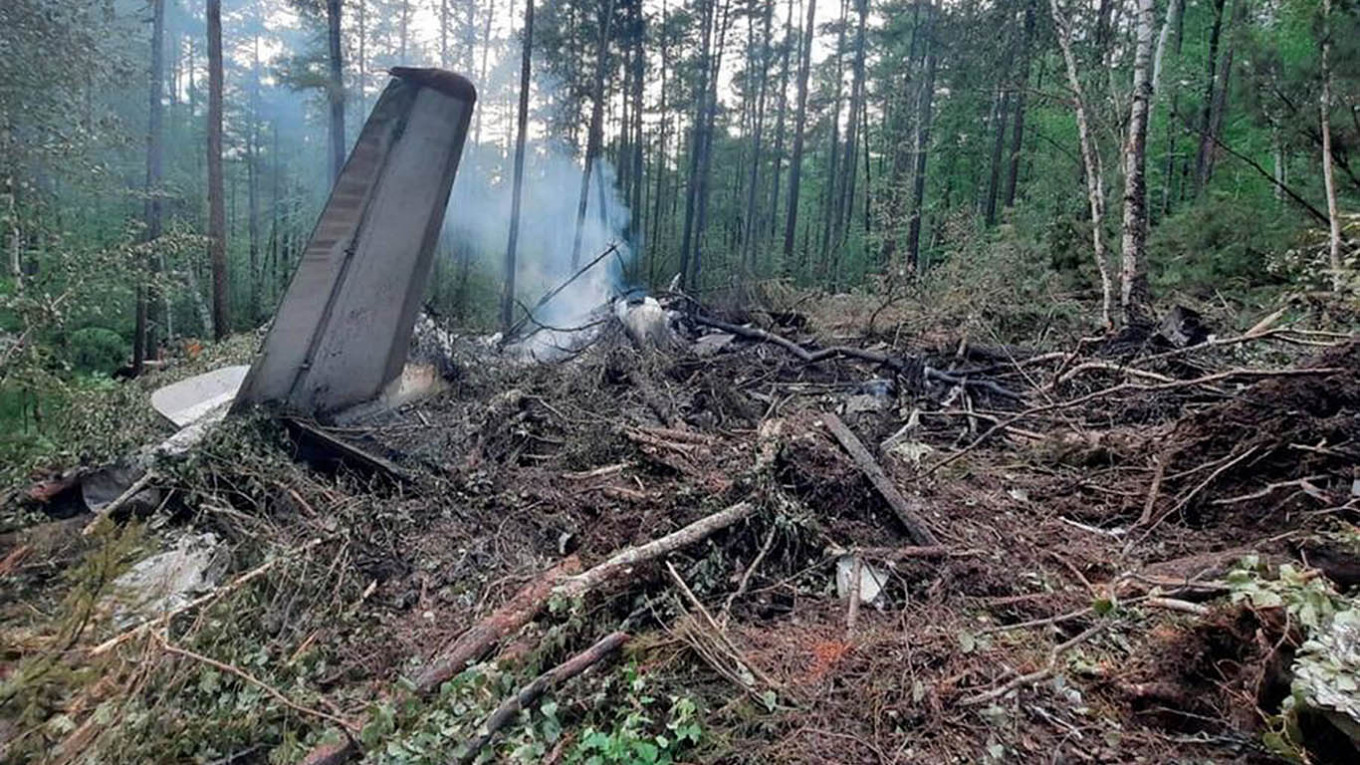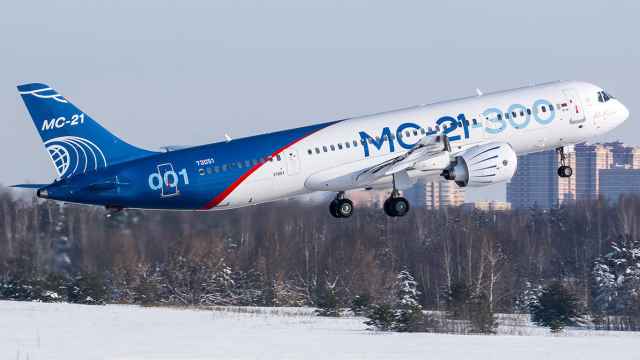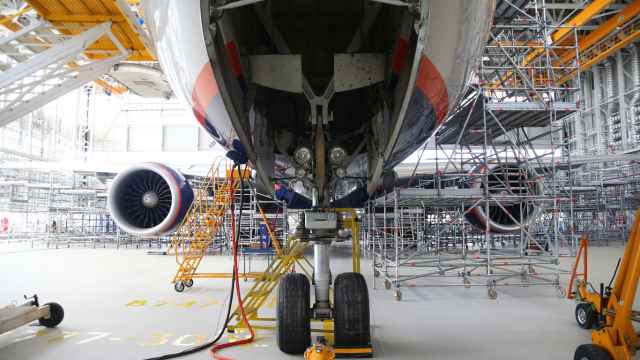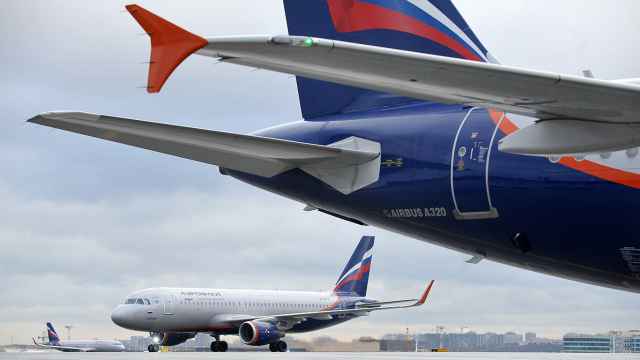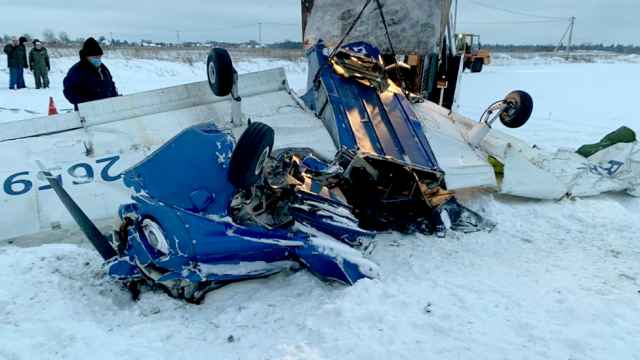Were it not for the pillar of smoke twisting above the thick pine forest, the scene might have resembled any other stretch of Russia’s vast and sparsely populated Far East.
Earlier that day, an Antonov An-24 with 48 people on board disappeared from radar on its approach to Tynda, a town in the China-abutting Amur region. When investigators arrived at the source of the smoke, they found only a crumple of metal among the trees and no survivors.
The July 24 disaster has prompted authorities to launch a probe of 51 regional airlines in an effort to improve safety standards in an industry that they say is seeing an upsurge in fatalities. This week, authorities grounded the carrier, Angara Airlines.
But while sanctions are battering the domestic air sector, the more notable trend appears to be a rise in technical incidents, not deaths, according to experts and industry monitors.
Data from German airline safety company JACDEC obtained by The Moscow Times indicates that Russia’s air fatalities have not notably spiked in recent years.
In fact, so-called “hull losses” — meaning the total destruction of an aircraft — have stayed relatively consistent, while “serious incidents” have seen only a slight increase. JACDEC’s data covers incidents involving civilian aircraft weighing more than 5.7 tons, or with at least 19 seats.
What is on the rise are lesser safety infractions that encompass everything from engine failures, fires and collisions to errors in takeoff and landing.
“We do see a rise in technical incidents … that could be attributed to a lack of supply chain and certified spare parts such as avionics, carbon brakes or engine turbine parts that affect the reliability of schedules,” said JACDEC CEO Jan-Arwed Richter. “But not to an extent where aircraft actually crash.”
The lack of a clear trend in air fatalities undermines the official narrative that they are on the rise.
At the same time, The Moscow Times’ findings suggest that the effects of sanctions — in particular, a lack of parts to repair aircraft — continue to strain domestic aviation, and that air travel appears to be becoming more unsafe.
Inspections could be an attempt to reassure an anxious public and ensure the country’s dwindling numbers of usable planes are fit to fly, experts said.
‘No alternative’
When news of the crash on July 24 broke, observers were quick to focus on the plane, a Soviet-made Antonov-24 that was reportedly 50 years old.
First brought into service in the early 1960s, the 52-seat aircraft powered by two turboprop engines is an example of the kind of outdated passenger plane on which domestic travelers are increasingly forced to rely in wartime Russia.
“For many regional routes, particularly in Siberia, airlines have no alternative but to continue operating older aircraft types, as many remote airports lack the infrastructure to accommodate newer or larger jets such as the Sukhoi Superjet,” explained Oleksandr Laneckij, the CEO of Lithuania-based consulting firm Friendly Avia Support.
Then came stories of the victims: people whose backgrounds were reminiscent of anyone’s neighbor or relative.
There was 71-year-old surgeon Leonid Maizel, who had been on the flight to visit his granddaughter and take her to the Far East city of Khabarovsk.
Flight attendant Anastasia Bessmertnaya, 43, was described by a colleague as “kind” and “vibrant.”
Sergei Shiyan, his wife and their 18-month-old daughter were on their way to visit his wife’s family.
Following the crash, the deputy director of Russia’s transport authority cited an increase in air-related fatalities between 2023 and 2024 as a reason for the mass inspections.
In December, authorities will begin a yearlong process of monitoring 51 regional airlines’ compliance with regulations, crew training and equipment performance.
Angara Airlines, the operator of the deadly July crash that was grounded this week, was first on the chopping block.
While the JACDEC data shows an increase in air fatalities from 2022 to this year, the full picture is more complex.
In reality, Russia’s average aircraft-related fatalities have remained relatively consistent over the past decade at about 30 per year. When looking at this time frame, the past three years do not appear out of the ordinary.
JACDEC’s data shows that the deadliest period for Russian aviation was from 2000-2010, when a spate of high-casualty crashes brought the annual average to 71 deaths.
The cause of July’s Antonov crash remains unclear. Investigators are reportedly considering both pilot error and technical malfunctions, which could be linked to sanctions, as contributing factors.
Laneckij said the situation bears all the signs of being caused by the latter.
“Sanctions have undoubtedly created the conditions that contributed to the accident,” he told The Moscow Times. “Without these restrictions, aircraft of such age would likely no longer be in operation.”
Older aircraft are more prone to technical issues. Since 2022, the jump in both minor and serious incidents in the data is unmistakable, an average of 66 per year.
As of October, there had already been more than 60 such incidents in 2025, according to JACDEC’s data.
Part of the increase can be attributed to more transparency in the publicly available sources that JACDEC uses to compile its databases, Richter, the company’s CEO, said.
These findings appear to be reflected in Russia’s own regulatory data. The Interstate Aviation Committee (IAC), which tracks aircraft incidents in Russia and neighboring countries, has not reported a notable increase in accidents since the start of the war, and recent years appear to show a decline in average injuries and fatalities.
“Looking at the data from [IAC] from 2023 to 2024, there really isn’t a significant uptick industry-wide in terms of safety becoming significantly worse,” said Steven Harris, a professor of history at the University of Mary Washington who researches Russian aviation.
Even though the IAC also covers the Caucasus and Central Asia, Harris said the data is still useful for drawing insights into Russian aviation.
Another caveat is that Russia’s self-reported data may paint an incomplete picture. Last year, the CEO of flight safety company RANAVIA claimed that the real number of air incidents may be higher than publicly known because airline workers choose not to report them.
An industry in trouble
These days, many airframes in Russia are sitting nearly abandoned across the country. A sector heavily impacted by sanctions, the commercial aviation industry has not been able to import crucial Western components for over three years, making these planes unsafe to use.
In a country as large as Russia, flying is often the only option to reach more far-flung regions, and airlines have evolved in an attempt to maintain services.
Some companies have been able to keep their fleets up to date by smuggling parts into the country. The government has paid billions of rubles in subsidies for aircraft manufacturing and keeping airlines afloat and to buy formerly leased planes. And in 2023, authorities legalized stripping aircraft for parts, a process crudely referred to as “cannibalization.”
Yet the conditions of Russia’s commercial aviation fleet are so dire that officials expect to retire more than 300 airplanes and 200 helicopters in the coming years, Dmitry Yadrov, the head of the Federal Agency for Air Transport, said this month. Nearly 30% of Western-made jets could be grounded by 2030.
At a meeting of the International Civil Aviation Organization last month, Russian authorities pleaded with Western counterparts for sanctions relief on Western aircraft components, reportedly framing the issue as a matter of safety.
Now, officials are doubtful they can continue patching over the issue, according to Harris, who is writing a book on Russia’s flag carrier Aeroflot.
In addition to calming a worried public, one motivation for the recent industry-wide inspections could be to ensure Russia’s dwindling commercial stock is able to shoulder increased demand.
“To their credit, they’re trying to sort of get ahead of this,” Harris said.
“On the other hand, there might be some other dynamics at play such as the state’s desire to consolidate the regional airline market, take over some of these smaller outfits,” he added. “Nothing like a stern performance review to serve as a pretext for that.”
Laneckij, the CEO of Friendly Avia Support, agreed that other factors could be motivating scrutiny of the industry, something that could alter its composition in the coming years.
“Aeroflot, as the country’s dominant carrier, has a strategic interest in consolidating the market by displacing weaker competitors,” he said. “Smaller and regional airlines, which typically lack significant political or financial support, are the most exposed to such pressure.”
A Message from The Moscow Times:
Dear readers,
We are facing unprecedented challenges. Russia's Prosecutor General's Office has designated The Moscow Times as an "undesirable" organization, criminalizing our work and putting our staff at risk of prosecution. This follows our earlier unjust labeling as a "foreign agent."
These actions are direct attempts to silence independent journalism in Russia. The authorities claim our work "discredits the decisions of the Russian leadership." We see things differently: we strive to provide accurate, unbiased reporting on Russia.
We, the journalists of The Moscow Times, refuse to be silenced. But to continue our work, we need your help.
Your support, no matter how small, makes a world of difference. If you can, please support us monthly starting from just $2. It's quick to set up, and every contribution makes a significant impact.
By supporting The Moscow Times, you're defending open, independent journalism in the face of repression. Thank you for standing with us.
Remind me later.



